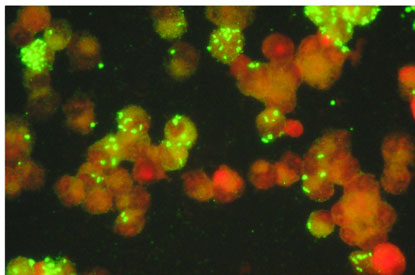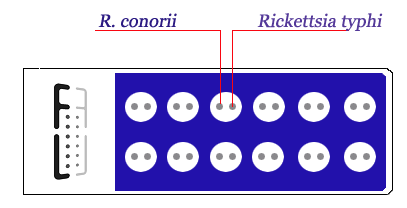Rickettsia
Rickettsia are zoonotic obligate intracellular bacteria of the family Rickettsiaceae. They are associated with arthropods, primarily ticks, but also including fleas, body lice and mites, which serve as the main reservoir. These arthropods also serve as vectors of rickettsiosis while feeding on both humans and animals.
The antibody response to infections by these agents is primarily directed against lipopolysaccharide (LPS) and 1-2 outer-membrane proteins (OmpA and/or OmpB). The standard IFA and MIF methods detect antibody against the whole organism and remain the most commonly used diagnostic methods. ELISA methods are also currently available which focus upon more specific reactivities to the lipopolysaccharide (LPS) antigens (IgG screening) and OmpB protein antigens (IgG/IgM).
For more information on specific Rickettsia species and associated products click here.
Rickettsia IFA substrate slides are available for all or most of the officially validated species, 16 of which are currently recognized as human pathogens. Due to the Class 3 nature of these organisms, our traditional substrate antigens have been formalin-inactivated prior to slide preparation.These slides contain Vero-76 cells with 30-40 infected cells per field when using a 40X lens.
Our new larger BSL3 facilities are allowing us the opportunity to prepare slides with infected substrate cells grown in situ within the slide wells. This line is being retooled to use acetone-fixation as the inactivation step and will be available in early 2011. The effect is subtle, but worth the effort.

Rickettsia MIF substrate slides are available for all or most of the officially validated species, 16 of which are currently recognized as human pathogens. These slides feature purified Rickettsia elementary bodies within a contrasting background matrix, with up to 6 antigens per slide well.
Several of the 2-3 antigen formats are stocked for general screening purposes (see image below). Other multi-antigen substrate slides are prepared on a custom basis with combinations of Rickettsia with other particulate antigens (Anaplasma, Ehrlichia, Coxiella, Bartonella, etc). This affords the opportunity for testing facilities to configure screening slides with broader or more specific utility.

Click here for complete Monoclonal catalogue and collections.
Rickettsia monoclonals have been produced against both protein and LPS (lipopolysaccharide) antigens of several species over the years. Some of the more popular ones have been made available for researchers in the field and are in stock, ready for shipping. Other clones require a few weeks of preparation.
Since those induced by immunization with outer-membrane proteins are rarely species-specific, the patterns of reactivity follow the relationships seen in the dendrogram of relationships. For example, Rickettsia conorii conorii may also react with R. conorii caspia and R. rickettsii, but not R. conorii indica. Graded reactivity to a range of different species is available for all clones (see individual datasheets). Please note that these reactivites were noted on formalin-inactivated whole cells by MIF testing.
In contrast, those clones induced by immunization with LPS show classic reactivity across the group. Monoclonal anti SFG LPS detects all spotted fever Rickettsia, while anti typhus group LPS reacts with both R. typhi and R. prowazekii. These reagents are especially useful for immuno-histochemistry (IHC) staining where the particular species may or may not be known, but a multi-purpose mouse monoclonal can detect it cleanly.
